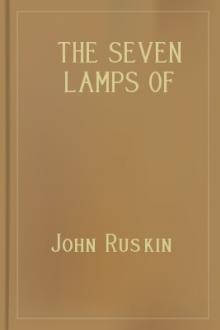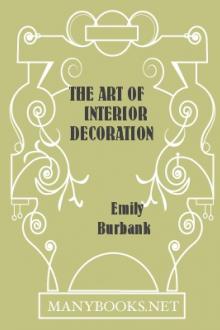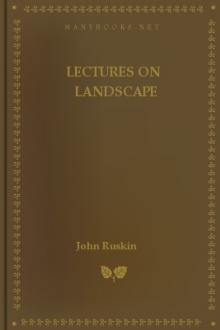The Seven Lamps of Architecture by John Ruskin (books like harry potter TXT) 📕

- Author: John Ruskin
- Performer: -
Book online «The Seven Lamps of Architecture by John Ruskin (books like harry potter TXT) 📕». Author John Ruskin
Page 43.
Compare Iliad Σ. 1. 219 with Odyssey Ω. 1. 5—10.
Note VII.Page 44.
"Does not admit iron as a constructive material."
Except in Chaucer's noble temple of Mars.
"And dounward from an hill under a bent,
Ther stood the temple of Mars, armipotent,
Wrought all of burned stele, of which th' entree
Was longe and streite, and gastly for to see.
And thereout came a rage and swiche a vise,
That it made all the gates for to rise.
The northern light in at the dore shone,
For window on the wall ne was ther none,
Thurgh which men mighten any light discerne
The dore was all of athamant eterne,
Yclenched overthwart and ende long
With yren tough, and for to make it strong,
Every piler the temple to sustene
Was tonne-gret, of yren bright and shene."
The Knighte's Tale.
There is, by the bye, an exquisite piece of architectural color just before:
"And northward, in a turret on the wall
Of alabaster white, and red corall,
An oratorie riche for to see,
In worship of Diane of Chastitee."
Page 44.
"The Builders of Salisbury."
"This way of tying walls together with iron, instead of making them of that substance and form, that they shall naturally poise themselves upon their buttment, is against the rules of good architecture, not only because iron is corruptible by rust, but because it is fallacious, having unequal veins in the metal, some places of the same bar being three times stronger than others, and yet all sound to appearance." Survey of Salisbury Cathedral in 1668, by Sir C. Wren. For my own part, I think it better work to bind a tower with iron, than to support a false dome by a brick pyramid.
Note IX.Page 60.
Plate III.
In this plate, figures 4, 5, and 6, are glazed windows, but fig. 2 is the open light of a belfry tower, and figures 1 and 3 are in triforia, the latter also occurring filled, on the central tower of Coutances.
Note X.Page 94.
"Ornaments of the transept towers of Rouen."
The reader cannot but observe agreeableness, as a mere arrangement of shade, which especially belongs to the "sacred trefoil." I do not think that the element of foliation has been enough insisted upon in its intimate relations with the power of Gothic work. If I were asked what was the most distinctive feature of its perfect style, I should say the Trefoil. It is the very soul of it; and I think the loveliest Gothic is always formed upon simple and bold tracings of it, taking place between the blank lancet arch on the one hand, and the overcharged cinquefoiled arch on the other.
Note XI.Page 95.
"And levelled cusps of stone."
The plate represents one of the lateral windows of the third story of the Palazzo Foscari. It was drawn from the opposite side of the Grand Canal, and the lines of its traceries are therefore given as they appear in somewhat distant effect. It shows only segments of the characteristic quatrefoils of the central windows. I found by measurement their construction exceedingly simple. Four circles are drawn in contact within the large circle. Two tangential lines are then drawn to each opposite pair, enclosing the four circles in a hollow cross. An inner circle struck through the intersections of the circles by the tangents, truncates the cusps.
Note XII.Page 124.
"Into vertical equal parts."
Not absolutely so. There are variations partly accidental (or at least compelled by the architect's effort to recover the vertical), between the sides of the stories; and the upper and lower story are taller than the rest. There is, however, an apparent equality between five out of the eight tiers.
Note XIII.Page 133.
"Never paint a column with vertical lines."
It should be observed, however, that any pattern which gives opponent lines in its parts, may be arranged on lines parallel with the main structure. Thus, rows of diamonds, like spots on a snake's back, or the bones on a sturgeon, are exquisitely applied both to vertical and spiral columns. The loveliest instances of such decoration that I know, are the pillars of the cloister of St. John Lateran, lately illustrated by Mr. Digby Wyatt, in his most valuable and faithful work on antique mosaic.
Note XIV.Page 139.
On the cover of this volume the reader will find some figure outlines of the same period and character, from the floor of San Miniato at Florence. I have to thank its designer, Mr. W. Harry Rogers, for his intelligent arrangement of them, and graceful adaptation of the connecting arabesque. (Stamp on cloth cover of London edition.)
Note XV.Page 169.
"The flowers lost their light, the river its music."
Yet not all their light, nor all their music. Compare Modern Painters, vol. ii. sec. 1. chap. iv. SECTION 8.
Note XVI.Page 181.
"By the artists of the time of Perides."
This subordination was first remarked to me by a friend, whose profound knowledge of Greek art will not, I trust, be reserved always for the advantage of his friends only: Mr. C. Newton, of the British Museum.
Note XVII.Page 188.
"In one of the noblest poems."
Coleridge's Ode to France:
"Ye Clouds! that far above me float and pause,
Whose pathless march no mortal may control!
Ye Ocean-Waves! that wheresoe'er ye roll,
Yield homage only to eternal laws!
Ye Woods! that listen to the night-birds singing.
Midway the smooth and perilous slope reclined,
Save when your own imperious branches swinging,
Have made a solemn music of the wind!
Where, like a man beloved of God,
Through glooms, which never woodman trod,
How oft, pursuing fancies holy,
My moonlight way o'er flowering weeds I wound,
Inspired, beyond the guess of folly,
By each rude shape and wild unconquerable sound!
O ye loud Waves! and O ye Forests high!
And O ye Clouds that far above me soared!
Thou rising Sun! thou blue rejoicing Sky!
Yea, everything that is and will be free!
Bear witness for me, wheresoe'er ye be,
With what deep worship I have still adored
The spirit of divinest Liberty."
Noble verse, but erring thought: contrast George Herbert:—
"Slight those who say amidst their sickly healths,
Thou livest by rule. What doth not so but man?
Houses are built by rule and Commonwealths.
Entice the trusty sun, if that you can,
From his ecliptic line; beckon the sky.
Who lives by rule then, keeps good company.
"Who keeps no guard upon himself is slack,
And rots to nothing at the next great thaw;
Man is a shop of rules: a well-truss'd pack
Whose every parcel underwrites a law.
Lose not thyself, nor give thy humors way;
God gave them to thee under lock and key."
[A] The inordinate delay in the appearance of that supplementary volume has, indeed, been chiefly owing to the necessity under which the writer felt himself, of obtaining as many memoranda as possible of mediæval buildings in Italy and Normandy, now in process of destruction, before that destruction should be consummated by the Restorer or Revolutionist. His whole time has been lately occupied in taking drawings from one side of buildings, of which masons were knocking down the other; nor can he yet pledge himself to any time for the publication of the conclusion of "Modern Painters;" he can only promise that its delay shall not be owing to any indolence on his part.
[B] 2 Sam. xxiv. 24. Deut. xvi. 16, 17.
[C] Mal. i. 8.
[D] Lam. ii. 11. 2 Kings xvii. 25.
[E] Num. xxxi. 54. Psa. lxxvi. 11.
[F] John xii. 5.
[G] Mod. Painters, Part I. Sec. 1, Chap. 3.
[H] Henceforward, for the sake of convenience, when I name any cathedral town in this manner, let me be understood to speak of its cathedral church.
[I] Literature of the Fine Arts.—Essay on Bas-relief.
End of Project Gutenberg's The Seven Lamps of Architecture, by John Ruskin
*** END OF THIS PROJECT GUTENBERG EBOOK THE SEVEN LAMPS OF ARCHITECTURE ***
***** This file should be named 35898-h.htm or 35898-h.zip *****
This and all associated files of various formats will be found in:
http://www.gutenberg.org/3/5/8/9/35898/
Produced by The Online Distributed Proofreading Team at
http://www.pgdp.net
Updated editions will replace the previous one--the old editions
will be renamed.
Creating the works from public domain print editions means that no
one owns a United States copyright in these works, so the Foundation
(and you!) can copy and distribute it in the United States without
permission and without paying copyright royalties. Special rules,
set forth in the General Terms of Use part of this license, apply to
copying and distributing Project Gutenberg-tm electronic works to
protect the PROJECT GUTENBERG-tm concept and trademark. Project
Gutenberg is a registered trademark, and may not be used if you
charge for the eBooks, unless you receive specific permission. If you
do not charge anything for copies of this eBook, complying with the
rules is very easy. You may use this eBook for nearly any purpose
such as creation of derivative works, reports, performances and
research. They may be modified and printed and given away--you may do
practically ANYTHING with public domain eBooks. Redistribution is
subject to the trademark license, especially commercial
redistribution.
*** START: FULL LICENSE ***
THE FULL PROJECT GUTENBERG LICENSE
PLEASE READ THIS BEFORE YOU DISTRIBUTE OR USE THIS WORK
To protect the Project Gutenberg-tm mission of promoting the free
distribution of electronic works, by using or distributing this work
(or any other work associated in any way with the phrase "Project
Gutenberg"), you agree to comply with all the terms of the Full Project
Gutenberg-tm License (available with this file or online at
http://gutenberg.org/license).
Section 1. General Terms of Use and Redistributing Project Gutenberg-tm
electronic works
1.A. By reading or using any part of this Project Gutenberg-tm
electronic work, you indicate that you have read, understand, agree to
and accept all the terms of this license and intellectual property
(trademark/copyright) agreement. If you do not agree to abide by all
the terms of this agreement, you must cease using and return or destroy
all copies of Project Gutenberg-tm electronic works in your possession.
If you paid a fee for obtaining a copy of or access to a Project
Gutenberg-tm electronic work and you do not agree to be bound by the
terms of this agreement, you may obtain a refund from the person or
entity to whom you paid the fee as set forth in paragraph 1.E.8.
1.B. "Project Gutenberg" is a registered trademark. It may only be
used on or associated in any way with an electronic work by people who
agree to be bound by the terms of this agreement. There are a few
things that you can do with most Project Gutenberg-tm electronic works
even without complying with the full terms of this agreement. See
paragraph 1.C below. There are a lot of things you can do with Project
Gutenberg-tm electronic works if you follow the terms of this agreement
and help preserve free future access





Comments (0)